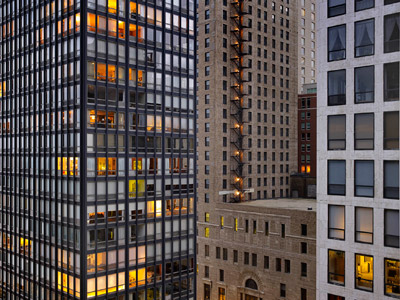MICHAEL WOLF: LIFE IN CITIES
| December 1, 2010 | Post In LEAP 6

It is usually just as dusk approaches: Michael Wolf silently scales a high-end office building downtown, resisting gales of wind as they howl across the concrete jungle. He raises his sniper rifle, holds his breath, and takes aim. His armament of choice: a medium format camera. His targets: New York, Chicago, Hong Kong, Tokyo, Paris, or any other highly globalized, highly capitalized metropolis.
M97 Gallery is situated along the Suzhou creek, where scrap metal warehouses lend the surroundings a distinctly postindustrial air. Roughly a kilometer away sits a high-density residential community built in the nineties. The complex’s numerous, crowded glass windows, glimmering radiantly with reflected sunlight, evoke to Le Corbusier’s utopian dream, Ville Radieuse, and serve as a metaphor for the portrait of a city fragmented and marginalized in a time of extreme expansion.
Upon entering the gallery, one feels as if reality and representation have begun to overlap; coming right after the view outside, the images within evoke a kind of deja vu. Suspended at the same height as their observers on all four walls and in the center of the room, they feature modern palaces with roofs and ground floor entrances elided. We can not find the buildings’ starting or ending points; they have fled from their frames. The rows of windows together seem to form enormous strips of barcode: each window representing one of big society’s little constituent units, with its own specialized purpose. And yet, at the same time, any one window just as easily turns into another number in a meaningless code of pure probability.
The office building is the ultimate symbol of capitalist bureaucracy. Skyscrapers, with a height impossible to behold with the naked eye alone, give those within them a superior advantage over those outside them. The skyscraper resident has a one-way view; his gaze goes unnoticed, but is omnipresent: what social theorist and geographer David Harvey aptly described as “the eye of God.” This was precisely what Michael Wolf, shooting photographs from tall buildings, sought to capture, up until the day when a peek into a window of one of his shots unexpectedly revealed a man holding up his middle finger. Using a 100x zoom to zero in on the contents of each Hitchcockian “rear window,” Wolf discovered a hundred bored individuals, one by one. Framed by their windows as if fettered in prison cells, isolated from their surrounding environments, they called to mind popular American realist painter Edward Hopper’s dreary rooms. Wolf “began to become intensely aware of [his] own voyeurism,” and started to convey this moral and philosophical state of introspection to his audience.
Interestingly, the show had a secondary venue inside of the famous Shanghai Times Square office building. One can’t help but wonder, for all of those white-collar workers dragging their exhausted bodies in and out of the office: is it their own shadow they see outlined in these photos? Meanwhile, against the background of this bustling, come-and-go environment, the sense of voyeuristic pleasure that these photos evoke is jarringly, publicly exposed; the spectator, standing just outside the window (the frame), can no longer play the role of the secure observer, awaiting the dramatic moment from a safely maintained distance.
The Parisian street photos shown in the same exhibition are among Wolf’s more experimental bodies of work. Blurry faces, superimposed images, and huge pixelated quadrants inevitably conjure up associations to Google’s virtual street view function. In these works, Wolf understands and communicates the color and variation of city life in terms of the continual flow, transfer, and exchange of digital information. The “surveillance” and “spying” of the virtual age are very real points of contention in the struggle of power and technology; in contrast to his previous works, which made lives and lifestyles visible and truly tangible, these photos increasingly stress the existence of the very media behind the observation. Tang Lingjie

